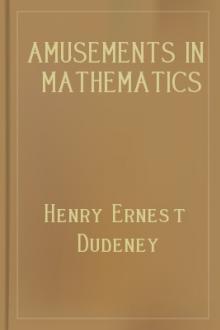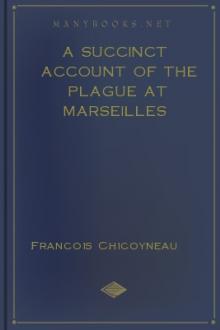Amusements in Mathematics, Henry Ernest Dudeney [books to read to be successful txt] 📗

- Author: Henry Ernest Dudeney
- Performer: 0486204731
Book online «Amusements in Mathematics, Henry Ernest Dudeney [books to read to be successful txt] 📗». Author Henry Ernest Dudeney
The difficult case of 7 persons on 15 occasions is solved as follows, and was given by me in The Canterbury Puzzles:—
In this case the 1 is a repeater, and there are two separate cycles, 2, 3, 4, 2, and 5, 6, 7, 5. We thus get five groups of three lines each, for a fourth line in any group will merely repeat the first line.
A solution for 8 persons on 21 occasions is as follows:—
The 1 is here a repeater, and the cycle 2, 3, 4, 5, 6, 7, 8. Every one of the 3 groups will give 7 lines.
Here is my solution for 9 persons on 28 occasions:—
There are here two repeaters, 1 and 2, and the cycle is 3, 4, 5, 6, 7, 8, 9. We thus get 4 groups of 7 lines each.
The case of 10 persons on 36 occasions is solved as follows:—
The repeater is 1, and the cycle, 2, 3, 4, 5, 6, 7, 8, 9, 10. We here have 4 groups of 9 lines each.
My solution for 11 persons on 45 occasions is as follows:—
There are two repeaters, 1 and 2, and the cycle is, 3, 4, 5,... 11. We thus get 5 groups of 9 lines each.
The case of 12 persons on 55 occasions is solved thus:—
Here 1 is a repeater, and the cycle is 2, 3, 4, 5,... 12. We thus get 5 groups of 11 lines each.
274.—THE MOUSE-TRAP PUZZLE.—solution
If we interchange cards 6 and 13 and begin our count at 14, we may take up all the twenty-one cards—that is, make twenty-one "catches"—in the following order: 6, 8, 13, 2, 10, 1, 11, 4, 14, 3, 5, 7, 21, 12, 15, 20, 9, 16, 18, 17, 19. We may also exchange 10 and 14 and start at 16, or exchange 6 and 8 and start at 19.
275.—THE SIXTEEN SHEEP.—solution
The six diagrams on next page show solutions for the cases where we replace 2, 3, 4, 5, 6, and 7 hurdles. The dark lines indicate the hurdles that have been replaced. There are, of course, other ways of making the removals.

276.—THE EIGHT VILLAS.—solution
There are several ways of solving the puzzle, but there is very little difference between them. The solver should, however, first of all bear in mind that in making his calculations he need only consider the four villas that stand at the corners, because the intermediate villas can never vary when the corners are known. One way is to place the numbers nought to 9 one at a time in the top left-hand corner, and then consider each case in turn.

Now, if we place 9 in the corner as shown in the Diagram A, two of the corners cannot be occupied, while the corner that is diagonally opposite may be filled by 0, 1, 2, 3, 4, 5, 6, 7, 8, or 9 persons. We thus see that there are 10 solutions with a 9 in the corner. If, however, we substitute 8, the two corners in the same row and column may contain 0, 0, or 1, 1, or 0, 1, or 1, 0. In the case of B, ten different selections may be made for the fourth corner; but in each of the cases C, D, and E, only nine selections are possible, because we cannot use the 9. Therefore with 8 in the top left-hand corner there are 10 + (3 × 9) = 37 different solutions. If we then try 7 in the corner, the result will be 10 + 27 + 40, or 77 solutions. With 6 we get 10 + 27 + 40 + 49 = 126; with 5, 10 + 27 + 40 + 49 + 54 = 180; with 4, the same as with 5, + 55 = 235 ; with 3, the same as with 4, + 52 = 287; with 2, the same as with 3, + 45 = 332; with 1, the same as with 2, + 34 = 366, and with nought in the top left-hand corner the number of solutions will be found to be 10 + 27 + 40 + 49 + 54 + 55 + 52 + 45 + 34 + 19 = 385. As there is no other number to be placed in the top left-hand corner, we have now only to add these totals together thus, 10 + 37 + 77 + 126 + 180 + 235 + 287 + 332 + 366 + 385 = 2,035. We therefore find that the total number of ways in which tenants may occupy some or all of the eight villas so that there shall be always nine persons living along each side of the square is 2,035. Of course, this method must obviously cover all the reversals and reflections, since each corner in turn is occupied by every number in all possible combinations with the other two corners that are in line with it.
Here is a general formula for solving the puzzle: (n² + 3n + 2)(n² + 3n + 3)/6. Whatever may be the stipulated number of residents along each of the sides (which number is represented by n), the total number of different arrangements may be thus ascertained. In our particular case the number of residents was nine. Therefore (81 + 27 + 2) × (81 + 27 + 3) and the product, divided by 6, gives 2,035. If the number of residents had been 0, 1, 2, 3, 4, 5, 6, 7, or 8, the total arrangements would be 1, 7, 26, 70, 155, 301, 532, 876, or 1,365 respectively.
277.—COUNTER CROSSES.—solution
Let us first deal with the Greek Cross. There are just eighteen forms in which the numbers may be paired for the two arms. Here they are:—
Of course, the number in the middle is common to both arms. The first pair is the one I gave as an example. I will suppose that we have written out all these crosses, always placing the first row of a pair in the upright and the second row in the horizontal arm. Now, if we leave the central figure fixed, there are 24 ways in which the numbers in the upright may be varied, for the four counters may be changed in 1 × 2 × 3 × 4 = 24 ways. And as the four in the horizontal may also be changed in 24 ways for every arrangement on the other arm, we find that there are 24 × 24 = 576 variations for every form; therefore, as there are 18 forms, we get 18 × 576 = 10,368 ways. But this will include half the four reversals and half the four reflections that we barred, so we must divide this by 4 to obtain the correct answer to the Greek Cross, which is thus 2,592 different ways. The division is by 4 and not by 8, because we provided against half the reversals and reflections by always reserving one number for the upright and the other for the horizontal.
In the case of the Latin Cross, it is obvious that we have to deal with the same 18 forms of pairing. The total number of different ways in this case is the full number, 18 × 576. Owing to the fact that the upper and lower arms are unequal in length, permutations will repeat by reflection, but not by reversal, for we cannot reverse. Therefore this fact only entails division by 2. But in every pair we may exchange the figures in the upright with those in the horizontal (which we could not do in the case of the Greek Cross, as the arms are there all alike); consequently we must multiply by 2. This multiplication by 2 and division by 2 cancel one another. Hence 10,368 is here the correct answer.
278.—A DORMITORY PUZZLE.—solution

Arrange the nuns from day to day as shown in the six diagrams. The smallest possible number of nuns would be thirty-two, and the arrangements on the last three days admit of variation.
279.—THE BARRELS OF BALSAM.—solution
This is quite easy to solve for any number of barrels—if you know how. This is the way to do it. There are five barrels in each row Multiply the numbers 1, 2, 3, 4, 5 together; and also multiply 6, 7, 8, 9, 10 together. Divide one result by the other, and we get the number of different combinations or selections of ten things taken five at a time. This is here 252. Now, if we divide this by 6 (1 more than the number in the row) we get 42, which is the correct answer to the puzzle, for there are 42 different ways of arranging the barrels. Try this method of solution in the case of six barrels, three in each row, and you will find the answer is 5 ways. If you check this by trial, you will discover the five arrangements with 123, 124, 125, 134, 135 respectively in the top row, and you will find no others.
The general solution to the problem is, in fact, this:
where 2n equals the number of barrels. The symbol C, of course, implies that we have to find how many combinations, or selections, we can make of 2n things, taken n at a time.
280.—BUILDING THE TETRAHEDRON.—solution
Take your constructed pyramid and hold it so that one stick only lies on the table. Now, four sticks must branch off from it in different directions—two at each end. Any one of the





Comments (0)